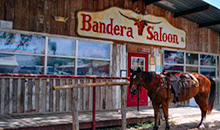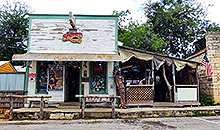Main Menu
Bandera County Data
Bandera County Communities & Places
Genealogy & History Links by USGHN
Important Bandera County Addresses
Sponsors
Bandera County Neighbors
Bexar County, Texas
Kendall County, Texas
Kerr County, Texas
Medina County, Texas
Real County, Texas
Uvalde County, Texas
Other Websites
Welcome to Bandera County Texas Genealogy & History Network!
Welcome to the Bandera County, Texas Genealogy & History Network. Our purpose is to provide visitors with free resources for genealogical and historical research. To share your genealogy or history information, send an email to txghn@outlook.com and we will happily include it here. For other Texas Counties, visit the Texas Genealogy & History Network state website and go to the appropriate county. Thanks for visiting and good luck with your research! |
|
About Bandera County, Texas...

Bandera County is twenty-five miles northwest of San Antonio in southwest Texas. The county seat and largest town is Bandera.
Archeological artifacts suggest that the earliest human inhabitants arrived around 6,000 to 10,000 years ago and settled in rock shelters. Lipan Apache and later, Comanche subsequently drifted into the area.
The first Europeans in what is now Bandera County were the Spanish. Bandera is Spanish for "flag." In 1853, James and DeMontel surveyed and platted the town of Bandera. By the fall of the same year the firm of James, Montel and Company built a horse-powered sawmill and opened a commissary store.
In March 1854 a group of Mormons led by elder Lyman Wight reached Bandera. The colony eventually settled a few miles below the town at a site known for many years as "Mormon Camp," which is now covered by Medina Lake. Wight died before the colony was fully established, and many of the colony moved on to Utah or settled in San Antonio. A small number, however, stayed, and their descendants still  live in the area.
live in the area.
In February 1855 sixteen Polish families arrived in Bandera to work in the sawmill, and in August of the same year August Klappenbach opened the first store and post office. On January 25, 1856, the legislature marked off Bandera County from portions of Bexar County; the new county was formally organized on March 10, 1856.
Because of its distance from the battlefields and the fact that there were so few slaves in the county, Bandera County was spared much of the trauma of the Civil War and Reconstruction. The decade of the 1870s, however, brought signs that Bandera County was slowly losing its frontier character. Indian attacks became less and less frequent, new stores opened, and stone increasingly replaced cedar logs as a building material.
Much of the economy in the early postwar period was dependent on cattle ranching. Bandera County was  a staging area for cattle drives up the Western Trail. During the late 1870s, however, the era of the great cattle drives was waning, and sheep, which were easier to feed on the sparse vegetation in the county.
a staging area for cattle drives up the Western Trail. During the late 1870s, however, the era of the great cattle drives was waning, and sheep, which were easier to feed on the sparse vegetation in the county.
The lack of good roads, however, kept the county relatively isolated. Because of the county's hilly terrain, the railroads bypassed it to the north or south, and ranchers were forced to use the arduous overland road to ship their products to market in San Antonio.
Despite the relative hardships, numerous new settlers arrived during the 1870s. The great majority of new settlers came from the South, though recent immigrants, especially Germans, formed an increasingly larger portion of the county's residents.
The onset of the Great Depression brought a marked downturn in prices for wool, and by the early 1930s many ranchers and residents found themselves economically strapped. Road building and other government-funded projects helped to employ some locals, but the economy did not completely recover  until the onset of World War II, when wool was in demand for the defense industries.
until the onset of World War II, when wool was in demand for the defense industries.
The tourist trade has also become a major source of the county's income. In 1920 Cora and Ed Buck began taking summer boarders at their ranch on Julian Creek. Other families soon advertised for guests, and Bandera, despite its relative isolation, became well known as a resort, with numerous restaurants, dance halls, and dude ranches. Such attractions such as the Frontier Times Museum, Bandera Pass, and the site of Camp Montel also bring in thousands of tourists and vacationers annually. Lost Maples State Natural Area, near Vanderpool in the west end of the county, is a birder's paradise known for its fall foliage display.
Hill Country State Natural Area is a 4,253-acre primitive camping area with trails for hiking and horseback riding. Numerous hunters are also drawn to the county because of its large deer and turkey population. Since 1990 many tourists come to Bandera Downs for pari-mutuel quarter horse and thoroughbred racing.
 The county has a total area of 798 square miles, of which 791 square miles is land and 7 square miles (0.8%) is water. The population recorded in the 1860 Federal Census was 399. The 2010 census recorded 20,485 residents there.
The county has a total area of 798 square miles, of which 791 square miles is land and 7 square miles (0.8%) is water. The population recorded in the 1860 Federal Census was 399. The 2010 census recorded 20,485 residents there.
Neighboring counties are Kerr County (north), Kendall County (northeast), Bexar County (southeast), Medina County (south), Uvalde County (southwest), and Real County (west). The county seat is Bandera. Other communities in the county include Lakehills, Lake Medina Shores, Bandera Falls, Medina, Pipe Creek, Tarpley, and Vanderpool.
Bandera County, Texas Records
Birth Records - The Texas Department of State Health Services has records from 1903 to present. Records for the last 75 years considered private and will only be provided to certain individuals. To obtain current information on who may obtain a record, how to submit a request and an official request form, see the Texas Department of State Health Services website or write to Texas Vital Records, Department of State Health Services, P.O. Box 12040, Austin, TX 78711-2040.
For older birth records you will have to write to the County Clerk of the applicable county. The existence of birth records prior to 1903 will vary widely from county to county. Local historical societies and genealogy collections in local libraries may be able to provide some information.
Death Records - The Texas Department of State Health Services has records from 1903 to present. Records for the last 25 years considered private and will only be provided to certain individuals. To obtain current information on who may obtain a record, how to submit a request and an official request form, see the Texas Department of State Health Services website or write to Texas Vital Records, Department of State Health Services, P.O. Box 12040, Austin, TX 78711-2040.
Marriage Records - The Texas Department of State Health Services can provide a verification letter of marriage for Texas marriages from 1966 to present. This is NOT a marriage license. To obtain a certified copy of a marriage license you must contact the County or District Clerk in the county or district where the marriage took place.
Local historical societies and genealogy collections in local libraries may be able to provide some information.
Divorce Records - The Texas Department of State Health Services can provide a verification letter of divorce for Texas divorces from 1968 to present. This is NOT a copy of the divorce decree. To obtain a certified copy of a copy of the divorce decree you must contact the County or District Clerk in the county or district where the divorce took place.
Local historical societies and genealogy collections in local libraries may be able to provide some information.




